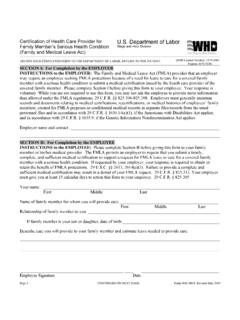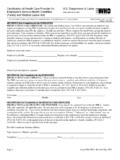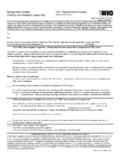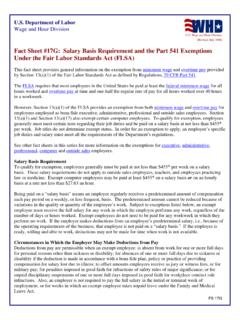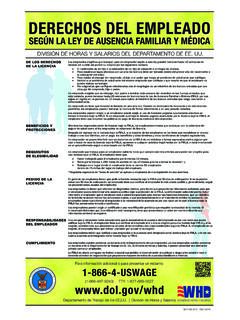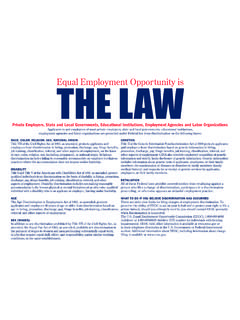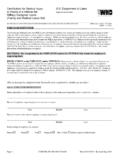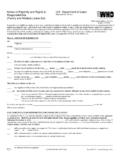Transcription of DOL Career and Credential Exploration (C2E)
1 1 department of labor DOL Career and Credential Exploration (C2E) January 2021 Edition Participant Guide DOL Career and Credential Exploration Participant Guide 2 Table of Contents Section 1: Getting Started .. 5 Objectives .. 5 Course Overview .. 5 High-Quality Civilian Career .. 6 Career Transition Timeline .. 7 Activity: What I'd Be Doing If I Wasn't Here? .. 8 Section 2: Vocational Training Foundation .. 10 What Is Vocational Training? .. 10 Why Pursue Vocational Training? .. 10 The Career Clusters .. 11 Career Clusters and Their Pathways .. 12 Activity: Identify Occupations Using the Career Cluster on O*NET .. 15 Activity: Career Cluster Exercise .. 16 Section 3: Self-assessments .. 19 What Is an Assessment? .. 19 Holland Codes Personality Types .. 20 Activity: RIASEC Exercise .. 21 Activity: O*NET Interest Profiler.
2 23 Career Clusters and the Holland Codes .. 25 Aptitude Assessment .. 27 Activity: CareerScope Assessment .. 31 Values Assessment .. 35 Activity: O*NET Work Importance Locator-Assessment .. 36 Status Check .. 42 Activity: Putting the Pieces Together .. 42 Section 4: labor Market Research .. 45 External factors .. 45 Occupational Research .. 46 Activity: O*Net Summary Report .. 46 Getting Help at the American Job Center (AJC) .. 48 Activity: Access the AJC Online .. 48 Section 5: Exploring Training Opportunities .. 51 DOL Career and Credential Exploration Participant Guide 3 Why Are credentials Important? .. 51 Common Types of credentials .. 52 Activity: Identify Qualifications and Requirements .. 53 Ways to Gain credentials .. 55 Activity: .. 56 Activity: Identify Training and credentials Opportunity .. 61 Gaining More Skills Before Transition.
3 63 Activity: United Services Military Apprenticeship Program (USMAP) .. 64 Activity: Using COOL .. 65 Funding Your Training and Education .. 66 Activity: GI Bill Comparison Tool .. 69 Factors to Consider When Seeking Vocational Training .. 71 Red Flags to Avoid When Seeking Vocational Training .. 72 Comparing Programs .. 74 Activity: Compare Programs .. 74 Additional Resources .. 78 Section 6: Designing the Path .. 82 Making a Plan for Success .. 82 Activity: Create an Action Plan .. 82 Summing It Up .. 86 Section 7: Appendix .. 88 O*Net Occupational Lists by Work Value .. 88 Job Zone Definitions .. 109 Website Guide .. 112 DOL Career and Credential Exploration Participant Guide 4 Getting Started 1 5 Section 1: Getting Started Welcome to the department of labor s Vocational Training Workshop. The purpose of this training is to provide you with information and a range of tools and resources to help you evaluate your Career options and gain the necessary training or credentials needed to pursue your vocational Career goals.
4 Objectives Upon completion of this training, you will have learned how to Define the concept of vocational training Complete and review self-assessments on skills, knowledge, and values to make informed Career decisions Identify and explore Career opportunities in each of the 16 nationally recognized Career clusters Identify the training requirements and types of credentials and qualifications needed for your occupations of interest Identify the associated costs and potential benefits of various apprenticeships, credentialing, or licensing goals Develop a plan of action by which you will accomplish a specific Career goal Course Overview The goal of this course is to provide you with the essential tools and resources you need to evaluate Career options, gain information for training and employment, and identify the next steps you should take to facilitate your transition to the civilian workforce.
5 Vocational Foundation Define the core concepts of vocational training Self-Assessment Complete and review self-assessments labor Market Research Identify and explore Career opportunities Training Opportunities Identify training requirements and options Design the Path Develop an action plan 6 High-Quality Civilian Career The purpose of the DOL s curriculum is to assist Service Members with their transition into a high-quality civilian Career . A high-quality civilian Career provides meaningful work, which allows one to utilize knowledge, skills, and abilities in an occupation that supports their values while earning a substantive wage. An investment in higher education or a training program can help to secure a high-quality civilian Career . Generally, the employment rate and earning potential are greater for those with marketable skills and higher levels of educational attainment.
6 According to the DOL s Bureau of labor Statistics, individuals with an associate degree, on average, earn 18% more than their counterparts with high school diplomas. Likewise, an individual with a bachelor s degree, on average, earns 64% more. According to the statistics released by DOL s Office of Apprenticeship, over the course of their Career apprenticeship graduates earn $300,000 more on average in wages and benefits than their peers who do not participate in a Registered Apprenticeship. 7 Career Transition Timeline This manual complements the Transition Assistance Program (TAP) curriculum by providing you with access to tools and best practices that will help you to transition from military service to a civilian Career . The curriculum s Career Transition Timeline is presented below. This timeline provides specific guidelines and timeframes to manage and navigate your journey toward a new Career path.
7 Career Transition Timeline Timetable 18 to 24 Months Before Transition 12 to 18 Months Before Transition 6 to 12 Months Before Transition 0 to 6 Months Before Transition Primary Activities Assessment and Career Exploration Preparation Activities Engagement Activities Transition Description Meet with local TAP Counselor Complete self-assessment Create a LinkedIn account Identify a mentor Begin exploring Career options If retiring, schedule/attend Initial Counseling and Pre-separation Counseling (can occur before 365 days, but no later than 365 days) Develop an Individual Transition Plan (ITP). If separating/ transitioning, schedule/attend Initial Counseling and Pre-separation Counseling (can occur before 365 days, but no later than 365 days) Register for/attend any remaining TAP workshops Explore SkillBridge or Career Skills opportunities Explore other training opportunities Create a master resume Begin & refine job search Complete targeted resume Sign up for a free year of LinkedIn Premium Subscription Targeted networking Practice interviewing Attend Career fairs Connect with an American Job Center (AJC) locally or at post-separation location Apply and interview for positions Continue to network and stay involved on LinkedIn and other social media sites Outcome High-Quality Civilian Career As you complete this course, be sure to update your Individual Transition Plan (ITP)
8 And think about how you can incorporate the information from the different modules into a customized, strategic, and actionable plan by which you can achieve your goals. Let s get started! DOL Career and Credential Exploration Participant Guide 8 Activity: What I'd Be Doing If I Wasn't Here? Share with the class the following information: Your name What you would be doing at work right now if you weren t here. Why you chose to complete the Career and Credential Exploration (C2E) training. What you hope to gain from this training. DOL Career and Credential Exploration Participant Guide 9 Vocational Training Foundation 2 DOL Career and Credential Exploration Participant Guide 10 Section 2: Vocational Training Foundation You may have an idea of your goals and the steps you need to take, but you still may be unsure of the vast Career and training options that are available.
9 In this section, you will learn about the foundation of vocational training and how it can help you achieve your Career goals. What Is Vocational Training? Vocational training is an educational program that provides students with instruction and training for a field or trade. It is also known as Career and Technical Education. The purpose of the program is to train students with a specific skill set to enter the workforce quickly and provide the technical skills they need to compete successfully in the global economy. Vocational training is typically based on a hands-on approach to learning where students are taught the practical skills and knowledge that employers are seeking. Traditional degree-granting colleges and universities, on the other hand, offer programs that are intended to provide students with a solid foundation of skills and knowledge related to a broad area of study.
10 For example, vocational training can prepare students for specific roles as dental hygienists, mechanical engineering technicians, fitness trainers, etc., whereas traditional degree-granting colleges prepare students for various careers in the business, science, or engineering fields. Why Pursue Vocational Training? There is a big demand for skilled labor . According to the Bureau of labor Statistics, there are now more job openings than there are workers, making it more challenging for employers to find qualified candidates to fill open positions. Truck driving, construction, information technology, health sciences, and electrical work are just some of the industries that are currently hardest hit by this labor gap. There are simply not enough people entering the skilled labor workforce to replenish the number of baby boomers retiring from these industries. DOL Career and Credential Exploration Participant Guide 11 Here are some reasons you should pursue vocational training: 1.

